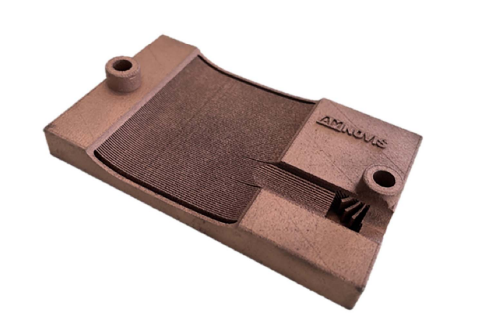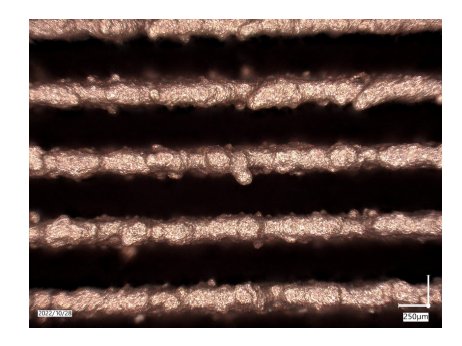Additive manufacturing production and engineering company Amnovis, has entered into an IP license agreement with KU Leuven, a research university in Belgium.
This agreement enables Amnovis to start commercially using a distinctive copper 3D printing technology, after six years of research. The new technology allows Amnovis to build copper parts with high conductivity and strength, tunable to unprecedented combinations that better serve a variety of industrial applications.
“Our copper and copper alloy 3D printing approach is built on a deep understanding of the laser powder bed fusion process (L-PBF). To maximize the use of this renowned and reliable AM technology, we developed excellent laser-absorptive powders based on the KU Leuven technology to overcome the high laser reflectivity and fast energy dissipation of copper material,” said Suraj Dinkar Jadhav, Amnovis’ Senior Materials Engineer.

What is the expected outcome of this collaboration?
Amnovis and KU Leuven’s close collaboration, specifically its SeMPeR and Additive Manufacturing research groups, includes an IP license agreement for a distinctive copper 3D printing approach. The accumulated knowledge propels copper 3D printing to a new level, allowing Amnovis’ customers to reap the benefits of this novel technology. Amnovis will be able to produce high-density, complex-shaped conductivity parts with cells embedded as thin as 200 microns.
Amnovis claims that its copper 3D printing method produces a convincing set of properties. According to the company, the material density exceeds 99%, and the printed material has improved electrical and heat conductivity. CuCr1Zr material can be printed with an electrical conductivity of up to 90% IACS and a thermal conductivity of up to 360 W/(mK), along with a yield strength of more than 500 MPa and an ultimate tensile strength of more than 600 MPa, and an elongation of 30%.
Amnovis’ proprietary laser-absorptive powders have ideal flowability and oxidation resistance. Consequently, the copper and copper alloy powders have less powder aging, improved reusability, and extended shelf life. The oxidation-resistant powders guarantee very little oxygen in the final product, preventing strength degradation after post-heat treatment.
“Our proprietary material and process expertise set a new standard for copper and copper alloy 3D printing. At the same time, we reduce costs by avoiding expensive green, blue and high-power lasers. Providing copper parts with unmatched material characteristics is a perfect example of how we want to innovate AM manufacturing. It enables customers to have superior copper parts printed by Amnovis and achieve stunning performance gains in various applications. For example, just imagine the potential of more efficient 3D printed CPU heat sinks used in the growing number of data centers,” said Ruben Wauthle, Amnovis CEO & Co-founder.
“Amnovis’ proprietary process enables to manufacture of copper components in a broad, stable, and affordable processing window. The broad processing window of this technology ensures repeatable and reproducible build quality,” added Amnovis’ Senior Materials Engineer.

Copper 3D printing
This year, Infinite Flex, a smart materials developer based in Germany, released what it describes as the world’s first pure copper powder for SLM 3D printing. The material, known as INFINITE POWDER Cu 01, has been developed and tested on a variety of standard SLM 3D printers, including the EOS M290 and Trumpf TruPrint 1000, and is also commercially available. In other news, Alloyed, a UK-based alloy design firm, also demonstrated its copper 3D printing application – a highly optimized cooling plate ideal for high-performance temperature regulation applications.
Previously, TRUMPF, a machine tool manufacturer from Germany, demonstrated the abilities of its TruPrint 5000 3D printer suitable for copper 3D printing along with its novel green laser technology. To process materials such as high-carbon steel or titanium alloy components, the TruPrint Laser Metal Fusion (LMF) 3D printer includes a 500 °C pre-heater and full-field multi-laser equipment with three 500 Watt fiber lasers. TRUMPF’s green laser is also said to have the potential to print gold in the jewelry industry.
Elsewhere, Markforged, a US-based composite, and metal 3D printer provider introduced a pure copper material option for use with the Metal X 3D printer. Markforged hopes to drive new manufacturing and supply chain efficiencies for customers by allowing copper 3D printing on the Metal X system, which is compatible with a variety of metal materials. Customers, according to the company, have the potential to reduce lead times and part costs when compared to conventional manufacturing processes for producing parts with commonly used metal.
Follow this link for all the Formnext 2022 news.
To stay up to date with the latest 3D printing news, don’t forget to subscribe to the 3D Printing Industry newsletter or follow us on Twitter, or like our page on Facebook.
While you’re here, why not subscribe to our Youtube channel? Featuring discussion, debriefs, video shorts, and webinar replays.
Are you looking for a job in the additive manufacturing industry? Visit 3D Printing Jobs for a selection of roles in the industry.
Feature image shows copper 3D printed part. Image via Amnovis.



